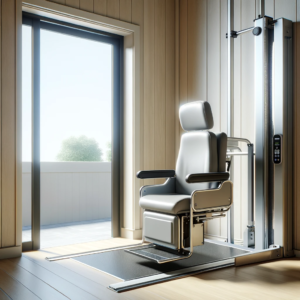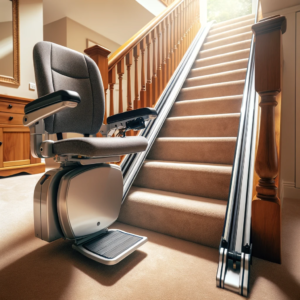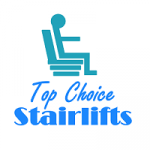Helping people with limited mobility to move from bed to wheelchair, or to another room, can be risky. Falls, for both patient and caregiver, are not uncommon. Caregivers can suffer muscle strain and damage, or even spinal injuries.
 Specialized homecare appliances can now significantly reduce the danger and stress of lifting a patient, allowing you to provide the best care possible.
Specialized homecare appliances can now significantly reduce the danger and stress of lifting a patient, allowing you to provide the best care possible.
People are able to be cared for at home, instead of in a care facility or hospital. The comfort and privacy of being at home are beneficial for a patient’s dignity and emotional well-being.
Handicap lifts are the most effective way to lift and move a disabled or elderly person. Depending on the type of lift installed, you can help a patient stand up, move from bed to wheelchair, or from one room to another.
Types of Handicap Lifts
Handicap lifts for homes are almost exactly the same as the lifts in hospitals.
They consist basically of a mechanical system attached to a sling.
The system can be steered manually with hydraulic assistance, or it can have power steering.
There are three main types of lifts that make caregiving safer and less stressful.
Fixed ceiling handicap lifts
Fixed ceiling lifts run on a railing system that is mounted to the ceiling beams of your home. The sling of the lift is connected to the rail, so it can run through various rooms of the house.
Caregivers help the patient into the sling, and use the controllers to move the motorized system around. This type of lift doesn’t take up floor space, and it’s the most common type of lift used for patients who are very heavy or have very limited capacity for movement.
Fixed ceiling lifts can either run throughout the home on a full track, or can be transferred from the track in one room to a track in another room.
Portable ceiling handicap lifts
These handicap lifts operate on a lightweight portable suspension system that almost resembles soccer goalposts. They are mounted on caster wheels and can be moved from room to room.
Portable lifts are manually steered by the caregiver. For this reason, they are less suitable than fixed lifts for heavy patients.
Hoyer lifts
Hoyer lifts consist of a lifting arm and sling system mounted onto a wheeled base. They can be used anywhere in the house. They are the best type of lift for patients who need to travel in a vehicle, as they can fold up with ease.
Which type of handicap lift is right for you?
There are numerous models of handicap lifts for homes.

It’s important to know what type of lift will suit your unique requirements.
Which type is right for the needs of both caregivers and patients?
Here are some important factors to discuss with a mobility consultant before you make that all-important decision of choosing your stairlift.
Type of transfer
Some people with limited mobility just need assistance to get out of bed and into a standing position, and move into their wheelchair by themselves. Others might not be able to stand at all, and need to be lifted into a wheelchair or onto the toilet.
Lift weight capacity
Does your patient or loved one need a bariatric lift? Handicap lifts have a weight capacity ranging from 300 pounds right up to 1,000 pounds.
You should consider whether you are able to manage the combined weight of the patient and the lift. A lift with power steering is a better option if you need extra assistance.
Lift controls
Controls for the lift are usually used by the caregiver and are positioned on the lift unit itself. Hand-held controllers are also available, suitable for patients who can operate the unit themselves. For most models, the lift is raised and lowered at the touch of a button.
Safety features
Make sure the lift you want to buy has the following safety mechanisms included:
- Speed controls to make sure the lift doesn’t lower too quickly, and injure the patient
- Emergency lowering system that allows you to lower the patient in the case of a power outage
- Secure sling attachment mechanism that prevents the sling from detaching
Handicap Lift Price
Handicap lifts have a wide range of functions, and a wide price range to match.
A portable or Hoyer lift that operates manually is the most economical at an average cost of $1,000. A portable ceiling lift will cost around $3,000. If you want a fully motorized ceiling lift with an extensive track system, you should budget for upwards of $14,000.
Take care to clarify whether the price of the handicap lift includes a patient sling – these are often charged separately. A sling on its own costs an average of $150, depending on function. Slings can be multi-purpose, bariatric, modified for bathing and toilet purposes, or designed simply to facilitate standing.
Conclusion
Decreased strength, balance, and coordination can affect people who are elderly, ill, morbidly obese, or recovering from serious injuries and surgery.
There are handicap lifts available to suit any mobility issue, and they can really help carers and their patients or loved ones to avoid injury while moving around. They also enable people to age in place for as long as possible.
Just like handicap stairlifts and platform lifts, these types of lifts can involve extensive modifications to a home. You might have to reinforce your ceilings, if you install a lift that runs on a permanent track in a number of rooms. On the other hand, some handicap lifts are compact and easy to maneuver.
Homeowners need to weigh up their options carefully, and decide on the handicap lift that suits their needs their best.
